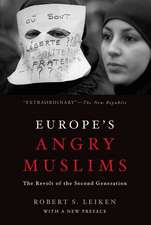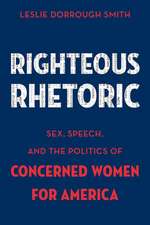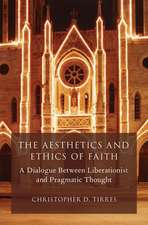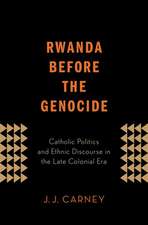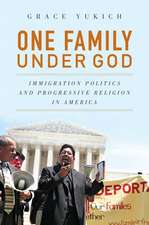Political Violence in Judaism, Christianity, and Islam
Autor Jonathan Fineen Limba Engleză Hardback – 26 mar 2015
| Toate formatele și edițiile | Preț | Express |
|---|---|---|
| Paperback (1) | 413.65 lei 6-8 săpt. | |
| Rowman & Littlefield – 25 mar 2015 | 413.65 lei 6-8 săpt. | |
| Hardback (1) | 672.72 lei 6-8 săpt. | |
| Rowman & Littlefield – 26 mar 2015 | 672.72 lei 6-8 săpt. |
Preț: 672.72 lei
Preț vechi: 921.54 lei
-27% Nou
Puncte Express: 1009
Preț estimativ în valută:
128.73€ • 137.65$ • 107.33£
128.73€ • 137.65$ • 107.33£
Carte tipărită la comandă
Livrare economică 18 aprilie-02 mai
Preluare comenzi: 021 569.72.76
Specificații
ISBN-13: 9781442247543
ISBN-10: 1442247541
Pagini: 274
Ilustrații: black & white illustrations
Dimensiuni: 177 x 231 x 24 mm
Greutate: 0.55 kg
Editura: Rowman & Littlefield
ISBN-10: 1442247541
Pagini: 274
Ilustrații: black & white illustrations
Dimensiuni: 177 x 231 x 24 mm
Greutate: 0.55 kg
Editura: Rowman & Littlefield
Notă biografică
Cuprins
General Introduction
Part One: The Origins of Political Violence and 'Terror'
Introduction to Part One
Chapter 1: Ancient and Medieval Concepts
1.1 Terror and Political Violence: How to Address the Topic?
1.2 The Ancient Near East
1.3 The Ancient Hebrews
1.4 The Greco-Roman World
1.5 Medieval Europe
1.6 The Arab World
Chapter 2: The Rise of Modern Secular-Agenda Political Violence
2.1 Revolutionizing the Term 'Terrorism'
2.2 Post-French Revolution Terminology
2.3 The Use of the Terms 'Terror' and 'Horror' in Modern Literature
2.4 Post-World War Two Guerrilla and Terrorist Organizations
2.5 Terrorism and the Media
2.6 The ¿Secular Formative Text"
2.7 Enemy-Definition in Western Culture and its Concept in Secular Terrorist Organizations and Guerrilla Movements
2.8 Secular Middle Eastern Groups
2.9 The Terminology of 'Terror' & 'Terrorism' in a Historical Perspective
Chapter 3: The Rise of Modern Religious-Agenda Political Violence
3.1 Religion and Political Violence in Early-Modern Political Thought
3.2 Political Science, International Relations, and Religion: Social Movement - Theory, Resource Mobilization Theory, Primordialism, Constructivism and Instrumentalism
3.3 Comparative Religion
3.4 Current Research on Holy War in Judaism, Christianity, and Islam
3.5 Current Research on Modern Jewish, Christian and Muslim Fundamentalism
3.6 The "Formative Religious Text": between Personality - Cult and Text Cult: a Different Approach
3.7 Enemy-Perception by Radical Religious Groups p. 74
3.8 Secular and Religious Texts on a Comparative Level: "Who is the -Enemey?"
Part Two: The Early Origins of Holy War in Monotheism:Judaism, Christianity, and Islam
Introduction to Part Two
Chapter 4: The Origins of Holy War in Judaism
4.1 Holy War Terminology in Judaism, Christianity, and Islam
4.2 The Hebrew Bible
4.3 Classic Jewish Interpretations: the Mishna
4.4 Classic Jewish Interpretations: the Babylonian and Palestinian Talmuds
4.5 Medieval Commentators: Rashi, Maimonides and Nahmanides
4.6 The Fate of Amalek and the Question of Total Eradication
4.7 Prohibition against National Revival by Force
4.8 The Midrash Interpretation: The Ill Fate of the Tribe of Ephraim
4.9 Apocryphal Literature: Enemy Definition and War in the War Scroll
4.10 Preliminary Changes in Jewish Interpretation towards the Three Vows: Rabbi Yosef Chaim
Chapter 5: The Origins of Holy War in Christianity
5.1 Unique Attributes of Holy War in Christianity
5.2 The Impact of Classic Sources
5.3 The Impact of Jewish Sources
5.4 Concepts of War and Peace in the New Testament
5.5 Government and State in the New Testament
5.6 The Concept of Just War in the Christian Roman Empire: FromConstantine to St. Augustine
5.7 Holy War and the Crusade
5.8 Thomas of Aquinas
Chapter 6: The Origins of Holy War in Islam
6.1 The Concept of Warfare in the Quran and the Meaning of Jihad
6.2 Post-Quranic Interpretations of the Term Jihad
6.3 Attitudes to Non-Muslims and the Concept of Dhimmi during Islam's Expansion
Part Three: From Holy War to Modern Terror
Introduction to Part Three
Chapter 7: The Rise of Modern Religious Violence in Judaism
7. 1 The Rise of Modern Nationalism and Anti-Semitism
7. 2 The British Mandate and the Impact of Rabbi Avraham Kook
7. 3 The Anti-Zionist Orthodox Camp
7. 4 The Impact of the Holocaust and Rabbi Moshe Yoel Teitelbaum
7. 5 Religious Violence Following the Establishment of the State of Israel
7. 6 The Impact of the Six Day War and the Yom Kippur War
7. 7 Reclaiming the Temple Mount
7. 8 The Six Day War and the Anti-Zionist Orthodox
7. 9 From Crisis to Violence: The Impact of the Camp David Accords, 1979
7.10 Rabbi Meir Kahane and the Kach Movement p.183
7.11 The Jewish Underground (ha Machteret ha Yehudit) and Yehuda Etzion
7.12 From the Oslo Agreements to the Second Intifada: 1993 ¿ 2000
7.13 The Evacuation of Gaza: 2005
7.14 'Torat ha Melech' ('The King's Way') and its Impact
7.15 'Price Tag' ¿ 'Tag Mechir'
Chapter 8: The Rise of Modern Religious Violence in Christianity
8.1 Early Modern Origins
8.2 Early Modern Pacifist Trends
8.3 The Discovery of the New World and the Attitude towards the Natives
8.4 Christianity, Enlightenment, War and Peace
8.5 Christian Attitudes towards War and Peace during the 19th Century
8.6 World War One and its Impact
8.7 The Resurgence and Failure of Pacifism: 1919-1939
8.8 World War Two and its Impact
8.9 Christian Attitudes towards War and Peace during the Cold War: The WWC and the 1965 Vatican Council on Modern War
8.10 The Rise of the 'Christian Right' in America
8.11 The Christian Right and the Ideology of Christian Zionism
8.12 Violence in the Name of God and the Christian Identity Groups in the US: From the KKK to the 'Army of God'
8.13 Christian Identity Groups Outside the US and the Massacre in Norway
Chapter 9: The Rise of Modern Religious Violence in Islam
9.1 General Background
9.2 Sunni Radicalism: the Rise of the Society of the Egyptian Muslim Brotherhood.
9.3 The Ideology of the Muslim Brotherhood
9.4 Shiite Radicalism: Ayatollah Khomeini and the Islamic Revolution in Iran
9.5 Abduallah Yusuf Azam and the Idea of Global Jihad
9.6 The Use of Violence and Redefining the Status of the Modern Dhimmi
9.7 The 'Afghan Alumni' and the Legacy of Azam
9.8. The Practice of Violence against the Enemy: Past and Present
9.9 The Impact of Radical Islam on the Palestinians
9.10 The Arab Spring
9.11 The Controversy Concerning Political Islam
Summary and Conclusions:
Bibliography
Descriere
Descriere de la o altă ediție sau format:
This analysis of the evolution of religious political violence outlines the differences between secular and religious political violence, on ideological, strategic, and tactical levels before comparing the concept of Holy War in Judaism, Christianity, and Islam. Lastly, it shows how modern radical monotheistic religious groups interpret and manipulate their religious sources and ideas to advocate their political agendas, including the practice of violence. A unique comparative study of religious political violence across Judaism, Islam, and Christianity, this text features many international case studies from the Crusades to the Arab Spring.

